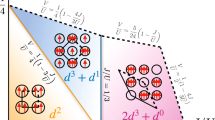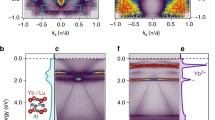Abstract
One of the main obstacles for the understanding of valence-fluctuation materials has been the absence of a clear model to illustrate the essential nature of the valence-fluctuation ground state. Our goal here is to present such a model, or rather, two closely related models, and to demonstrate that they have a number of intuitively reasonable features.
Access this chapter
Tax calculation will be finalised at checkout
Purchases are for personal use only
Preview
Unable to display preview. Download preview PDF.
Similar content being viewed by others

References
B. H. Brandow, Ground State and Elementary Excitations of a Model Valence-Fluctuation System,Int. J. Quantum Chem Symposium Vol. 13 (1979)(in press).
M. Avignon, F. Brouers, and K. H. Bennemann, Effects of Phonons in Mixed Valence Systems, J. de Physique 40: C5 - 377 (1979).
K. W. H. Stevens, Non-Orthogonal Orbitals in Intermediate Valency, J. Phys. C11: 985 (1978).
B. H. Brandow, Linked-Cluster Expansions for the Nuclear Many- Body Problem, Rev. Mod. Phys 39: 771 (1967).
B. H. Brandow, Electronic Structure of Mott Insulators, Adv. Phys 26: 651 (1977).
F. Holtzberg, T. Penny, and R. Tournier, Valence Instabilities of Tm in its Compounds and Solid Solutions, de Physique 40:C5-314 (1979); A. Berger, P. Haen, F. Holtzberg, F. Lapierre, J. M. Mignot, T. Penny, O. Pena, and R. Tournier, One Impurity Effect of Tm in YSe-Kondo Effect and Van Vleck Behavior, J. de Physique 40: C5 - 364 (1979).
R. M Martin and J. W. Allen, Theory of Mixed Valence: Metals or Small Gap Insulators (Magnetism and Magnetic Materials Conference, 1979), J. Appl. Phys. (in press)
T. Kasuya, K. Takegahara, T. Fujita, T. Tanaka, and E. Bannai, Valence Fluctuating State in SmB6, J. de Physique 40: C 5–308 (1979).
Author information
Authors and Affiliations
Editor information
Editors and Affiliations
Rights and permissions
Copyright information
© 1980 Plenum Press, New York
About this chapter
Cite this chapter
Brandow, B.H. (1980). Ground States and Magnetic Responses of Model Valence-Fluctuation Systems. In: Crow, J.E., Guertin, R.P., Mihalisin, T.W. (eds) Crystalline Electric Field and Structural Effects in f-Electron Systems. Springer, Boston, MA. https://doi.org/10.1007/978-1-4613-3108-7_39
Download citation
DOI: https://doi.org/10.1007/978-1-4613-3108-7_39
Publisher Name: Springer, Boston, MA
Print ISBN: 978-1-4613-3110-0
Online ISBN: 978-1-4613-3108-7
eBook Packages: Springer Book Archive



